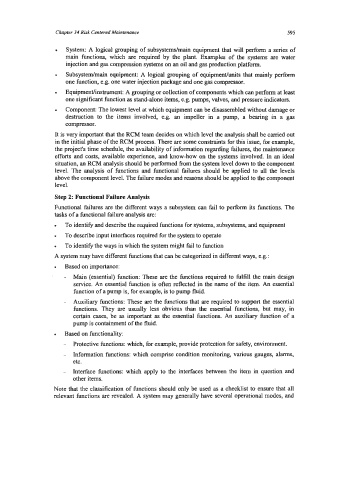Page 619 - Marine Structural Design
P. 619
Chapter 34 Risk Centered Maintenance 595
System: A logical grouping of subsystemddn equipment that will perform a series of
main functions, which are required by the plant. Examples of the systems are water
injection and gas compression systems on an oil and gas production plafform.
Subsystdmain equipment: A logical grouping of equipmenffunits that mainly perform
one function, e.g. one water injection package and one gas compressor.
Equipmenffinstrument: A grouping or collection of components which can perform at least
one significant function as stand-alone items, e.g. pumps, valves, and pressure indicators.
Component: The lowest level at which equipment can be disassembled without damage or
destruction to the items involved, e.g. an impeller in a pump, a bearing in a gas
compressor.
It is very important that the RCM team decides on which level the analysis shall be carried out
in the initial phase of the RCM process. There are some constraints for this issue, for example,
the project's time schedule, the availability of information regarding failures, the maintenance
efforts and costs, available experience, and know-how on the systems involved. In an ideal
situation, an RCM analysis should be performed fiom the system level down to the component
level. The analysis of functions and functional failures should be applied to all the levels
above the component level. The failure modes and reasons should be applied to the component
level.
Step 2: Functional Failure Analysis
Functional failures are the different ways a subsystem can fail to perform its functions. The
tasks of a functional failure analysis are:
To identify and describe the required functions for systems, subsystems, and equipment
To describe input interfaces required for the system to operate
To identify the ways in which the system might fail to function
A system may have different functions that can be categorized in different ways, e.g.:
Based on importance:
- Main (essential) function: These are the functions required to fulfill the main design
service. An essential function is often reflected in the name of the item. An essential
function of a pump is, for example, is to pump fluid.
- Auxiliary functions: These are the functions that are required to support the essential
functions. They are usually less obvious than the essential functions, but may, in
certain cases, be as important as the essential functions. An auxiliary function of a
pump is containment of the fluid.
Based on functionality:
- Protective functions: which, for example, provide protection for safety, environment.
- Information functions: which comprise condition monitoring, various gauges, alarms,
etc.
- Interface functions: which apply to the interfaces between the item in question and
other items.
Note that the classification of functions should only be used as a checklist to ensure that all
relevant functions are revealed. A system may generally have several operational modes, and

